Table of Contents
- Introduction
- Tara Jodoin, Project Initiator
- Guest Post: The Trail Valley Creek Team from Wilfrid Laurier University
- Laura Salisbury, Geomatics Officer at Natural Resources Canada
- Guest Post: Lindsay Faye Armstrong, MSc. Candidate from the University of Ottawa
- Kyla Hvatum, Federal Student Work Exchange Program (FSWEP) Student at Natural Resources Canada
- Guest Post: Melanie Desjardins, Manager of the NWT Centre for Geomatics
- Alice Deschamps, Geomatics Specialist at Natural Resources Canada
- Guest Post: Kimberley Geeves, Research Assistant, Simon Fraser University
- Katelynn Martin, Federal Student Work Exchange Program (FSWEP) student at Natural Resources Canada
- Guest Post: Allison Dykstra, MSc. Candidate from the University of New Brunswick
Introduction

An initiative from GeoConnections of Natural Resources Canada, Career Alliance 360 - Inspiring Girls in STEM / Indigenous Inclusion is designed to enhance representation of women and Indigenous Peoples in key STEM fields with a particular emphasis on northern Canada.
This summer, four pilot projects are running under the program:
- Community Outreach and Capacity Building in Inuvik, NWT
- Enabling Indigenous People in Canada's North with Geospatial Technology
- Building Northern Capacity to Collect and Share UAV-Based Mapping Products Through the CGDI
- Earth Observation in support of flood risk management - Pilot project for operational river ice breakup monitoring
Follow our blog to get to know the Career Alliance 360 summer projects, learn about scientific research conducted by women and Indigenous Peoples in northern Canada, and read about their experiences in STEM.
Tara Jodoin, Project Initiator
Tara Jodoin is a Projects Officer with Agriculture and Agri-Food Canada. In the community, she is an executive steering committee member of Ottawa Community Beekeepers as well as a member of the Eastern Ontario Beekeepers Association. Tara conceptualized the Career Alliance 360 - Inspiring Girls in STEM / Indigenous Inclusion initiative that provides women with leadership experience, engages youth and the Indigenous community in STEM fields, and inspires mentorship and corporate knowledge transfer. Read on to learn about Tara's inspirations, her initiative's journey, and her own experience with math and science.
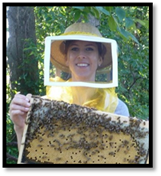
A former professor of mine once talked about the remarkable strength and stability of a spider web due to its incredible ability to adapt to different stresses. The spider's silk, stronger than steel and more elastic than nylon, has researchers exploring opportunities to apply its unique characteristics in human tools such as in formulating bulletproof vests.
The spider's web reminds me of our team - individuals, rich in diversity - from all angles, working hard to weave together various areas of knowledge and expertise. Just as the silk of a web changes and adapts as it encounters a slight push or pull, so does our multifaceted team when faced with challenges.
I was first inspired by the movements of Élizabeth Leblanc, in her efforts to support employment equity. I too, wanted to weave together traits that are essential to our team strength: strength that enables us to continuously improve our service to our fellow Canadians - Diversity, Inclusion, Respect, and Innovation.
My Director General at the time, Prashant Shukle, had tasked me with coordinating a women in science & technology discussion for his management team and I in turn asked to go one step further with an action plan. Without his support, encouragement, and connecting me with brilliant women such as Corrine Charette, Vidya ShankarNaraya, and Ashley Casovan with the Women in Communication and Technology National Public Sector Network, and Dawn Nicholson-O'Brien who delivered the workshops that inspired my initial efforts, this initiative would not have grown into the success it is today.
I was driven to take action because I struggled with math and sciences when I was younger and rather than encourage me to persevere, I was directed towards an easier route. Several years ago, I made it my goal to obtain all of the math and science credits I missed out on in high school. l was fascinated with what I learned and obtained final grades in the 90s. Young girls and Indigenous youth should not be made to believe that to struggle means you're not smart enough. This is something I would stress to a women or Indigenous person considering a career in STEM. Would the butterfly still be strong enough to fly if she did not first struggle during her development? We all need mentors, role models and spokespeople who care about our future and can guide us through our struggles. One thread of silk alone may be fragile but when woven with endless strands, continuously changing, challenging and supporting each other, the possibilities are limitless...
I've learned the journey and the evolving plan is more important than the initial static concept. In welcoming new suggestions and learning about my colleagues' challenges, together we begun weaving an initiative designed to address various challenges we face together. My one true hope is that this project continues to welcome and engage diversity no matter how far from the original path that goal may lead us.
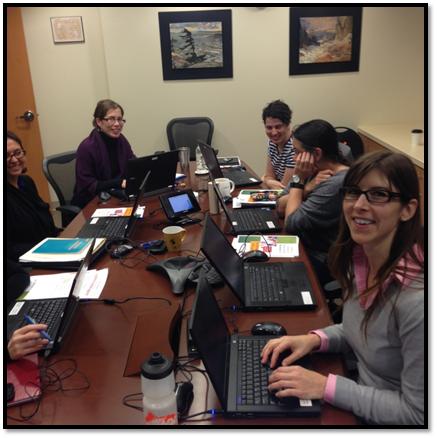
Left to right - Genevieve Marquis (not pictured), Alice Deschamps, Carla Vanessa Schmitt, Kristina Kwiatkowski, Sophie Sliwa, and Tara Jodoin learning new skills at a Microsoft Project Workshop.
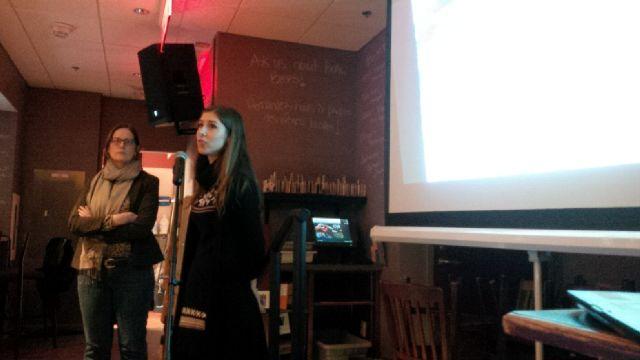
Left to right - Corinna Vester and Tara Jodoin presenting the CCMEO Career Alliance 360 - Inspiring Girls in STEM/Indigenous Inclusion initiative at a Women in Science and Engineering (WISE) Ottawa event.
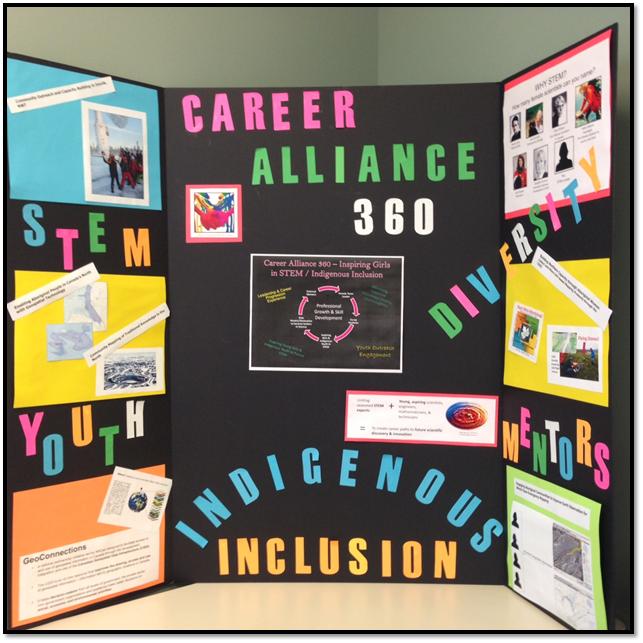
Team Project Material for the Women in Communications and Technology Public Sector Conference in December 2015.
Guest Post: The Trail Valley Creek Team from Wilfrid Laurier University
Katie Black (MSc student) and her field assistants, Emily Way-Nee and Jenna Rabley, are from Dr. Jennifer Baltzer's Forest Ecology Lab at Wilfrid Laurier University in Waterloo, Ontario. With support from the Aurora Research Institute in Inuvik, NT, Katie and her team are conducting research at Trail Valley Creek in the Western Arctic. We asked the team about their field work, the importance of their research to those living in the North, and their advice to young women and indigenous people interested in pursuing a career in STEM fields.
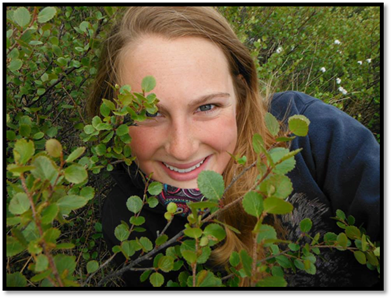
Katie Black in a patch of Betula glandulosa shrubs at Trail Valley Creek.
Could you explain your Master's research project?
K: Climate warming is driving the proliferation of tall shrubs across the tundra biome with implications for energy balance, hydrology, nutrient cycling, and tundra biodiversity. I'm interested in understanding the mechanisms that influence the expansion of tall shrub patches in tundra ecosystems. Changes in tundra plant water use attributable to tall shrub expansion are predicted to increase evapotranspirative water loss which may amplify local warming and reduce run-off.
To make predictions about the consequences of tall shrub expansion, it is necessary to understand the abiotic factors that constrain shrub distribution. Tall shrubs are preferentially expanding in areas that have a higher potential of accumulating moisture, such as drainage channels and hill slopes. My thesis work focuses on understanding the interactions between water availability, nutrient availability, and topographic features to gain insight into green alder shrub distribution and water use at Trail Valley Creek near Inuvik in the Northwest Territories. Understanding the drivers and limitations of tall shrub expansion is essential for predicting future tundra conditions.
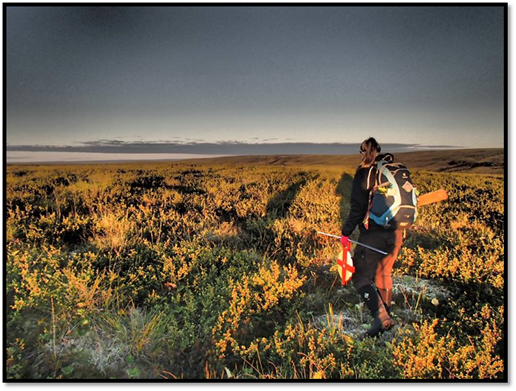
Katie walking back to Trail Valley Creek Research Camp after a day of field work on the low Arctic tundra.
Why is your research important for those living in the North?
K: Shrub expansion has many implications for tundra wildlife and northern lifestyle. For example, canopy shading caused by increased tall shrub cover has been shown to reduce tundra species richness through the loss of shade-intolerant plants. A decline in tundra species richness may impact Arctic food webs and ecosystem services that are valuable to northerners. For instance, it has been demonstrated that as tall shrub cover increases, lichen cover decreases. Lichen is an important food source for caribou, and thus declining lichen cover may negatively impact caribou populations, which in turn may alter the success of hunting and herding practices. Additionally, shrub expansion has the potential to interfere with traditional travelling, hunting, and harvesting routes by causing routes and harvesting sites to become overgrown with tall shrubs.
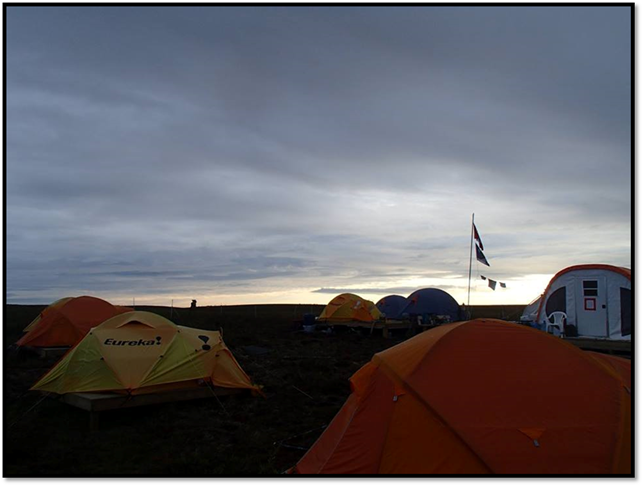
The Trail Valley Creek Research Camp.
What is it like to be field assistants for Katie's research project?
E&J: We are both very pleased to be field assistants for Katie's project. The opportunity has given us lots of experience with data collection and organization. Our positions allow us to gain insight into how research is conducted at the MSc level, which will be helpful when it comes to our time to consider pursuing a MSc and/or an independent research project. Some of our responsibilities include using scientific equipment to collect data and learning and identifying local plant species. We also play an active role in maintaining our remote research camp. One of the highlights of being a field assistant is that we get to travel to new places and work with great people!
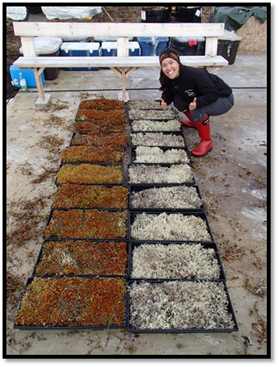
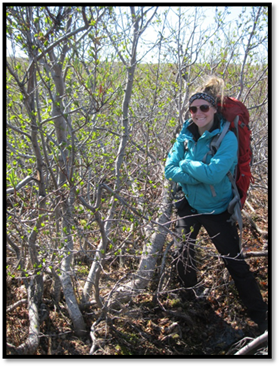
Emily (left) posing with moss and lichen samples collected for a substrate experiment being conducted by Cory Wallace (PhD candidate). Jenna (right) in a patch of Alnus viridis shrubs in Siksik creek.
As a woman in science, what are some challenges you have faced?
K: Personally, I have never really considered how being a female would influence my role as a student or a scientist. Since I dove into the field of science, I have received nothing but support from colleagues and supervisors, male and female alike. The only challenge that I have seen my female colleagues encounter is the accusation of not being 'strong enough' for the hard labour of field work. Don't give the ladies the lighter pack or the easier task - challenge us so that we can show you just how strong we can be!
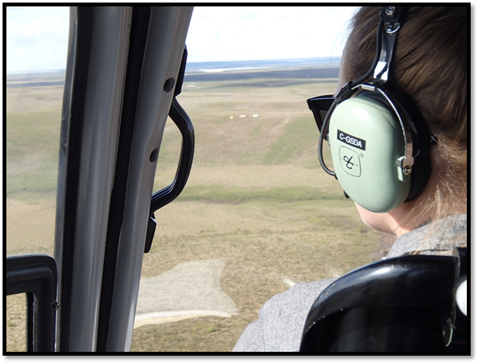
Katie travelling to Trail Valley Creek via helicopter.
What would you tell a young woman or indigenous person interested in pursuing a career in STEM fields?
K: Get involved! Volunteer at your local science centre, talk to people in the field of interest, or participate in relevant courses and/or programs. Before you choose a career path, it's important to first experiment with different fields of science to figure out where your interests lie. If you have the motivation, confidence, and foundational knowledge, you are likely to succeed.
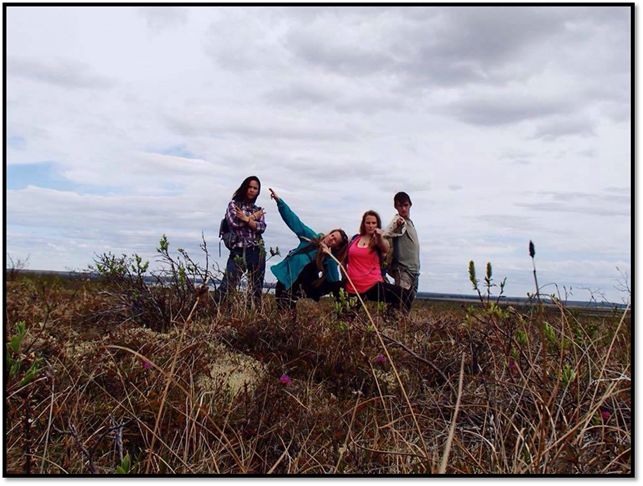
Emily, Jenna, Katie, and Cory striking a pose.
For more information about Katie's research and Dr. Jennifer Baltzer's Forest Ecology Lab, visit www.forestecology.ca.
Laura Salisbury, Geomatics Officer at Natural Resources Canada
Laura Salisbury is a Geomatics Officer at Natural Resources Canada hired through the "Career Alliance 360" program, and working on the "Community Outreach and Capacity Building in Inuvik, NWT" project. Recently graduated with a Master of Science in geography from Carleton University, Laura is thrilled to be a part of such a special project at the very beginning of her career.
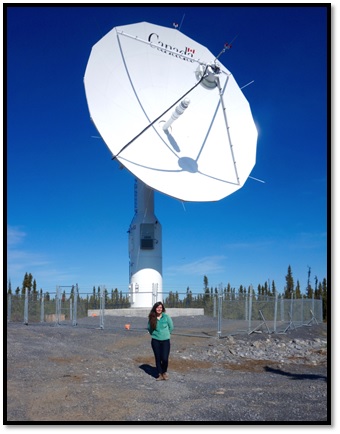
Laura standing in front of the ICAN1 antenna at the Inuvik Satellite Station Facility (ISSF) in Inuvik, NWT.
This summer, my task is to lead two FSWEP students through all stages of a 7-week geomatics project based in Inuvik, NWT. As part of the Inuvik Satellite Station (ISSF) Development Program, we are developing visualization products for those interested in learning more about the ISSF, satellite technologies, and the Town of Inuvik.
Our first product is an ArcGIS Story Map, the main goal being to tell the story of the ISSF in an interactive, powerful, and fun way. We are including a mini-lesson on satellites and remote sensing, information about the land-claim agreements in the area, and mapped out hot spots in Inuvik including trails, shopping, tourist attractions, and even utilidor shortcuts.
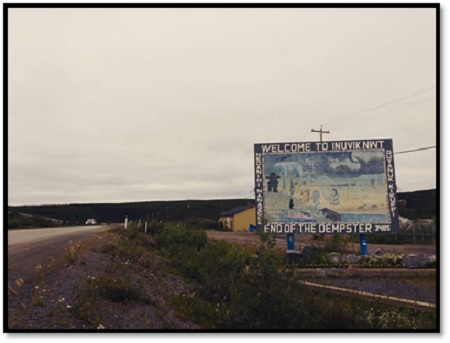
Welcome to Inuvik, NWT.
We are also working on creating a Minecraft world following the steps of Eric Storie, a City of Ottawa GIS Analyst who created geoOttaWOW, a Minecraft world of Ottawa. We are using real GIS data from GeoGratis and the NWT Centre for Geomatics, and transforming it with Feature Manipulation Engine (FME), a data conversion program built by Safe Software. Hopefully we can even add in 3D models of the antennas using Google Sketch Up.
These deliverables are fun to produce, expose the ISSF to a wider audience, and teach the students geomatics, computer science, and creativity skills. The students are getting familiar with many types of software (ArcGIS, QGIS, FME), online mapping (ArcGIS Online), and field work involving GPS receiver units. They are also getting a taste of what it's like to work for Natural Resources Canada, learning about the ISSF, and gaining valuable workplace skills such as teamwork, time management and resourcefulness.
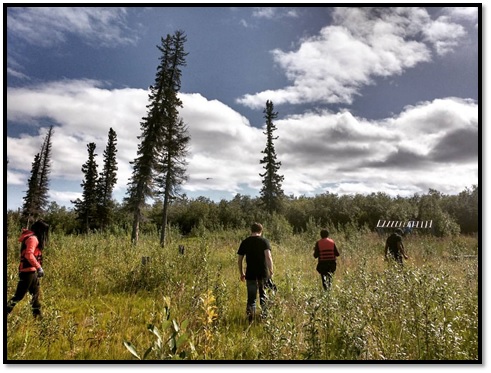
Collecting GPS tracks on the Mackenzie Delta.
As for young women and/or aboriginal youth unsure about their place in a predominately white and male field... I think the following advice applies:
"Don't ask yourself what the world needs. Ask yourself what makes you come alive, and go do that, because what the world needs is people who have come alive."
- Howard Thurman
Do what makes you happy, and the rest will follow. If that is a career in science, engineering, technology, mathematics, visual arts, or even construction, you owe it to yourself to try it out. Even if that means that you are initially placed out of your comfort zone.
Guest Post: Lindsay Faye Armstrong, MSc. Candidate from the University of Ottawa
Lindsay Faye Armstrong is a Master of Science candidate from the University of Ottawa. With support from the Aurora Research Institute in Inuvik, NT, and under the supervision of Denis Lacelle (U Ottawa), Lindsay and her assistant Hugo Crites are conducting research near the Yukon/NWT border in the Western Arctic. We asked Lindsay about her field work, the importance of her research to those living in the North, and her advice to young women and indigenous people interested in pursuing a career or education in STEM fields.
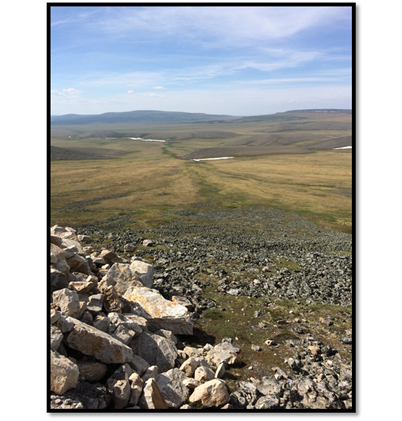
Lindsay's field site is very close to the NWT/Yukon border. This is a view to the south, Yukon.
In a nutshell, my project is focused on methods development in 3D modeling, and my target is permafrost 'thaw slumps'. I'm trying to exploit existing techniques to make a new method that is better suited for longer time periods and remote environments. I'm using several time-lapse cameras to shoot overlapping views of my target slump. From this data, I can hopefully build a time series of models, from which I can pull information about their shape and rate of degradation. This information could help us better understand how these features relate to local weather events, the type of permafrost below, and even the affect on the surrounding streams.
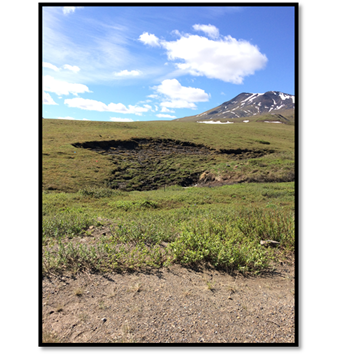
The target slump as it appeared before the installation. After installation, 13 cameras on poles sit in a row, and coloured discs act as markers to help the model recognize familiar objects.
This is important to northerners because research up north is increasingly important as climate changes, but is often times logistically difficult. If successful, my method could make collecting larger data sets more feasible. This would mean we could learn more, in a shorter amount of time.
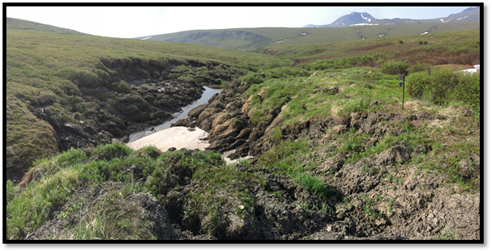
A second slump the team outfitted with a reconnaissance camera. They will monitor for change this season, and if the slump is very active, they may install a full time lapse set up next year. Notice the camera on a pole rear center right.
I have had many varying responses on the topic of my being a woman in science. As a child, I was fortunate enough to be raised in an environment in which I was never defined by my gender. I was allowed to dress and act as I liked, as long as I was kind and respectful. It wasn't until I was older that I realized the liberty I had been given, and experienced the opinions of others about what my role as a woman should be. I've been asked questions about how I intend to manage a future family and a career, or heard comments about how surprising it is that I can understand math. Although the comments can sometimes be hurtful, I try to remember what my parents taught me. You can do anything you want to do. But whatever it is you choose to do, do it well. Don't let anyone tell you can't do something. Simply make it your mission to kindly, prove them wrong.
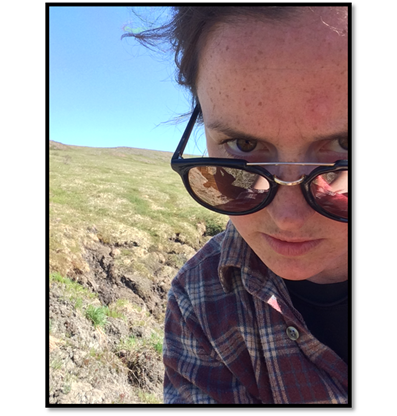
Lindsay as seen by one of her cameras as she programmed it.
As a young person entering a career in science, my advice to youth with a budding interest in science, is to ask questions. About everything. About things that interest you, about things you don't understand, or even about things you do understand. Other people may have different ideas than yours, or those you have learned. Sometimes scientists can seem intimidating, but they are regular people like you or I. Sometimes they use words that are complicated or unfamiliar, but asking them questions helps them better explain themselves, and will allow you to better understand your interests in science. Science is designed to be a sharing of ideas. If you are interested in a career in science, it's important to learn to communicate your ideas, and listen to those of others. This will not only help science do its job, but will help you practice to have a mind that is equally skeptical as it is open to new ideas. Science needs wisdom and knowledge, but also curiosity and creativity!
Kyla Hvatum, Federal Student Work Exchange Program (FSWEP) Student at Natural Resources Canada
Kyla Hvatum just graduated from East Three Secondary School in Inuvik, NWT. She was hired as an FSWEP student to work on the "Community Outreach and Capacity Building in Inuvik, NWT" project under the "Career Alliance 360: Inspiring Girls and Indigenous Youth in STEM" program.. This fall, Kyla is heading off to the University of British Columbia to start a Kinesiology program.
It wasn't until one of my teachers told me about a new position opening here in Inuvik, that I heard the word geomatics. I am on my way to university this fall, yet I had no understanding of this subject that I may possibly want to pursue if I knew more about it. Not knowing a thing about it, I decided to put my application in, in hopes of widening my knowledge on foreign subjects that may essentially lead up to my choice of work in the future.
Within the past 3 weeks of our work together Nicole and I have gained a lot of new skills with different technologies and computer software from our leads in the project, Laura and Matthew. We've used programs such as FME, ArcGis Online, ArcGis, QGIS, Story Maps, and even how to incorporate these tools into Minecraft. We aren't yet at the point of completely understanding these programs, but we are quickly learning to take different types of data and convert them into the desired format in order to portray the information as easy and useful as possible.
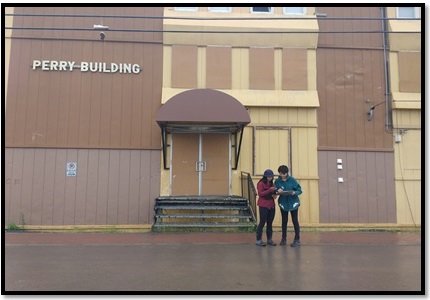
Kyla Hvatum (left) and Nicole Collison (right), another FSWEP student, marking a waypoint using a GPS receiver.
Not only are we learning to use the specific computer software, but we have become quite accustomed to using navigational systems, specifically a GPS and the program it uses to convert the data to a computer. We've gone out on a couple field trips to practice our coordinate accuracy in hopes to be prepared for more crucial field work that will be of use to the town and people travelling to our community for the first time. So far we have made our way out to the satellite station to capture the coordinates of the dishes and around the town to get the location of shortcuts and trails.
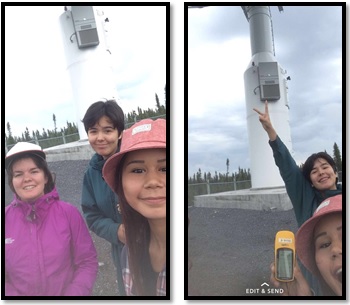
Welcome to Snapchat, ISSF! From left to right: Laura Salisbury, Nicole Collison, and Kyla Hvatum.
To sum up half the time span of my job, I have accomplished some short term goals that I thought I'd never even been able to interpret. Such as building some sort of terrain in online generated worlds, specifically Minecraft, and capturing real data points that will be useful to other individuals. I have been enjoying this type of work since I started, and hope to further my knowledge in the geomatics field in the future. I am very excited to see the final product of our project! I know it will be something to be proud of.
Guest Post: Melanie Desjardins, Manager of the NWT Centre for Geomatics
Melanie Desjardins is the Manager of the Northwest Territories Centre for Geomatics in Yellowknife. In her time off, she likes cycling, canoeing with her family, and exploring the North. We asked Melanie about her career path, how she got into geomatics, and if she had any advice for young people looking to study or work in STEM fields.
My curiosity about nature and science was influenced from an early age by the stacks of National Geographic magazines strewn about my family home. As a young girl, I never saw limits to my career possibilities but also never quite aspired toward a specific path in Science, Technology, Engineering or Mathematics (STEM). I was artistic, I liked the outdoors and interacting with people, and I enjoyed problem solving. Although family PCs were just gaining popularity at the time, I never envisioned a career that was centered on the use of computers and advanced software. That was more my brother's thing!
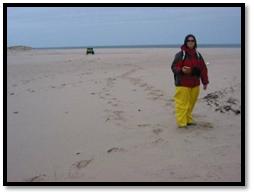
I pursued a Bachelors of Science degree in Biology after high school without an end-game in mind. It wasn't until my last year of university that panic set in about how to start a career in a field I had no practical experience in, aside from theoretical knowledge. A professor and mentor suggested I continue my education in geomatics to gain more marketable skills. What the heck is geomatics, I thought! After a bit of research I discovered that geomatics was a type of computer science. Was this really for me and would I be able to keep up? Despite my fears I registered for a post graduate diploma program at the Centre of Geographic Sciences in Nova Scotia. From the beginning I was amazed that I would be so captivated by a computer-oriented field, yet still apply my interests in nature, the environment and the arts. Soon after, I found myself programming and liking it, including its endless problem solving.
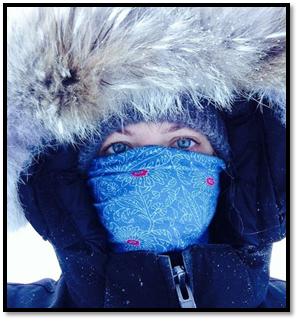
Choosing this career path has allowed me to travel to interesting places like Sable Island, Nova Scotia, to map its ever changing landscape. It also launched a 12 year career with Parks Canada, where I mapped everything from the migration patterns of the endangered Inner Bay of Fundy Salmon to the critical habitat of the threatened Eastern Massasauga Rattlesnake.
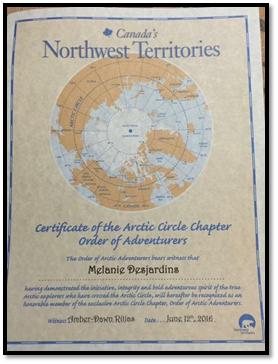
Currently, I manage the NWT Centre for Geomatics for the Government of the Northwest Territories, and part of my role is to engage clients, stakeholders and youth toward a culture of geomatics and STEM. For northern youth in particular it is important to show that STEM sector jobs, like geomatics, are relevant to them and are within their reach and their communities. My advice to them would be to find a mentor, be it a teacher, an employer, a coach or an elder; ask for guidance on seeking career opportunities that relate to personal interests and traditional knowledge. I would also tell them to not be discouraged by a sector that is dominated by a particular demographic. There's no telling what I'd be doing today if I had.
Alice Deschamps, Geomatics Specialist at Natural Resources Canada
Alice Deschamps is a Geomatics Specialist at Natural Resources Canada. She is the team lead for the "Earth Observation in support of flood risk management - Pilot project for operational river ice breakup monitoring" under the"Career Alliance 360 - Inspiring Girls in STEM / Indigenous Inclusion" program. In her spare time, Alice enjoys yoga, cycling, gardening and simply spending time in the great outdoors.
The Emergency Geomatics Service (EGS) at Natural Resources Canada supports emergency response activities by producing and disseminating in Near Real Time (NRT) GIS-ready satellite-based products to a large community of emergency responders at both the federal and provincial level. Prior to working with the EGS team, I was involved with a remote sensing research team that worked on river ice. Therefore when a request came from Public Safety Canada in the spring of 2014 asking EGS to provide support for ice jam monitoring in Northern Ontario, I was able to provide some demonstration products. These were well received and as a result, a pilot project was setup with the Ontario Ministry of Natural Resources to demonstrate the benefits of earth observation as a complementary source of information for ice breakup monitoring in remote area where in-situ data is sparse. To make this possible the automation of the exiting tools was increased but the biggest hurdle remains validating the ice products in NRT (below).
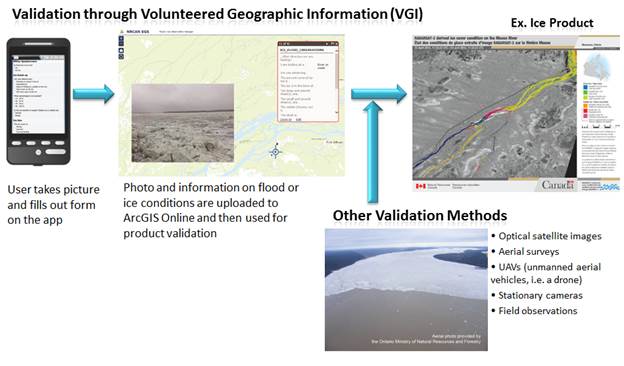
Figure 1: Validation through Volunteered Geographic Information (VGI) workflow. User takes picture and fills out form on the app. Photo and information on flood or ice conditions are uploaded to ArcGIS Online and then used for product validation (Ex. Ice Product). Other Validation Methods: optical satellite images, aerial surveys, UAVs (unmanned aerial vehicles, i.e. a drone), stationary cameras, and field observation.
We also wanted to expand this pilot study and engage others groups/organisations who may benefit from these types of products. The STEM project will fund the staffing of 3 female COOP students to support the work of the EGS team in achieving these goals. This will provide the students with an opportunity to work on an interesting operational project with a world class geomatics team. I strongly believe that COOP work terms should provide students with valuable job experiences, networking opportunities and help them "test-drive" their career choice!
The field of geomatics has grown exponentially in the last 10 years and the demographics are slowly changing. As a new graduate or COOP student, I suggest taking the time to work on a variety of projects to get exposure to the vast opportunities that exist in geomatics. This will help you find your niche! I also encourage female STEM students not to shy away from programming; it is a beast worth taming! Having basic programming skills will prove to be very useful in your career and open up a world of opportunities for you in the field of geomatics.
Guest Post: Kimberley Geeves, Research Assistant, Simon Fraser University
Meet Kimberley Geeves (BSc), a research assistant for Mitchell Bergstresser (MSc student) from Dr. Lance Lesack's Limnology Lab at Simon Fraser University, Burnaby, British Columbia. With help from the Aurora Research Institute (ARI), Mitchell and Kimberley are conducting research on the lakes within the Mackenzie River Delta, located near Inuvik, NT. Read further to learn about how Kimberley hopes to make the transition from research assistant to having her own project next summer, and her advice to young women and Indigenous people interested in pursuing a career in STEM fields.
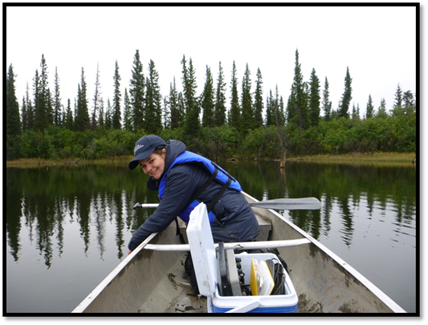
Kimberley collecting methane samples from Lake 280. The main focus of their research consists of a set of six lakes from The Delta, all of which are accessible by motorboat or canoe.
Due to recent warming in Canada's Western Arctic, research on methane within the Mackenzie River Delta has become an increasing topic of interest. Presumably, microbial communities within the lakes of the Delta are complexly linked to the amount of methane present, playing an integral role in the net flux of methane into the atmosphere. Since little is known about the microbial communities in the Delta, our research focuses on characterizing the structure and activity of methane-cycling microbes in the water and sediment within various lakes, and ultimately trying to tease apart the methane cycle in this complex system. As we all know, there are serious implications affecting the North due to rising temperatures. Our research will contribute to improving our understanding of the role of methane in the Delta.
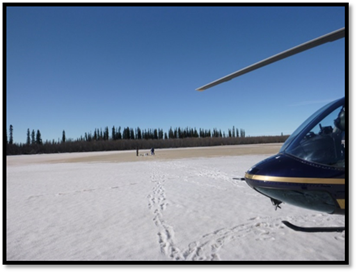
Kimberley and Mitchell collecting water and sediment samples from under the lake ice during their pre-ice out helicopter survey of 23 lakes within The Delta.
Being selected to work as a research assistant in the Arctic is just one step closer to my achieving my goal of a career in science. I have high hopes to return next summer and complete my own research project as a graduate student. I have always had a passion for research and science, but my journey to get where I am now has not always been easy. It takes a lot of hard work and dedication to achieve your utmost ambitions. My biggest advice to young women and Indigenous people interested in pursuing a career in STEM fields is to be confident in following your passions and most importantly, never give up! We are all faced with our own challenges that might seem like obstacles, but the trade-off is well worth it. The world is a big place full of many opportunities, and a career in science is one of them!
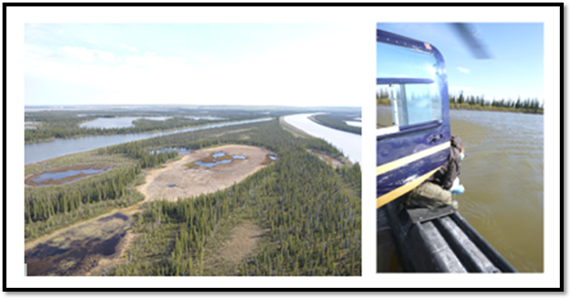
Aerial view of the Mackenzie Delta (left). Mitchell collecting water during their open-water helicopter survey of 43 lakes (right).
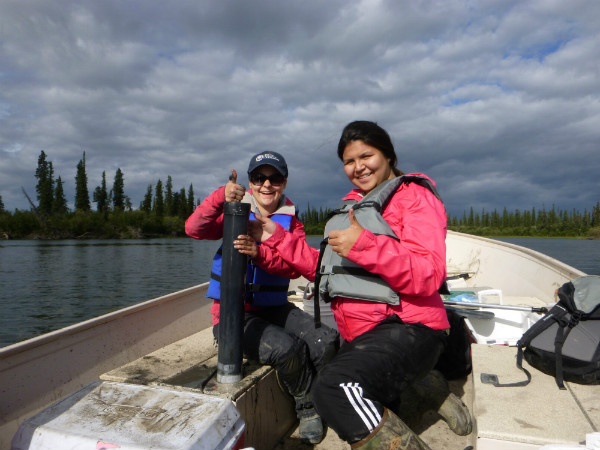
Kim (left) and her Gwich'in summer student (right) out in the field.
Katelynn Martin, Federal Student Work Exchange Program (FSWEP) student at Natural Resources Canada
Katelynn Martin is a third-year student at the University of Ottawa, in the Bachelor of Arts program with Specialization in Geography with a minor in Geomatics and Spatial Analysis. This summer, she is working at NRCan through the FSWEP program as a toponymy technician for the "Enabling Indigenous People in Canada's North with Geospatial Technology" under the "Career Alliance 360: Inspiring Girls and Indigenous Youth in STEM" program.
I have always been a creative and curious person. For some reason, when I was younger, I thought that these two skills could only be applied to an art. During my second year of university, I realized I could never have been so wrong.
Geography and geomatics opened up a world to me that I did not know existed, and when I finally stumbled upon it, I felt extremely lucky. Not only did it have everything I ever wanted rolled into one, but it challenged me to be all those things and use all those skills, all at once. I discovered that my degree combined my interests of the physical world with those of the human world. In the same day, I could learn about glaciers and human activity, I could also learn about environmentalism, and how to make maps. Beyond this, the experiences and assignments would provide me with opportunity to learn how to incorporate the side of me that was artistic and creative, with the side of me that liked to think critically and pay attention to detail. In the past, I have always tried very hard to differentiate these two sides, yet now I am in a world that not only encourages me to mesh them together, but requires it. The most valuable lesson Geography and GIS has taught me, is to never separate two worlds.
I am currently working at Natural Resources Canada (NRCan) as a toponymy Technician within the Geographical Naming Board of Canada (GNBC) group. Before getting this job at NRCan, I had never heard the word toponymy. As a student in a geography program, I felt disappointed to find out that there are no courses on toponymy offered at my school. At the same time, I was also excited to discover a new world that fell underneath the same umbrella as my geography world.
My work as a toponymy technician student at the GNBC focuses on finding and analysing discrepancies in toponym data using GIS. Currently, I am working with three toponym data files on First Nation reserves and using QGIS to map reserve coordinate points with their associated reserve polygons. In brief, the purpose of the analysis is to find all discrepancies and pinpoint why exactly they are happening. This work is really interesting if you like to use GIS to problem solve. I personally find the work mind-numbing and mind-bending at the same time...in a good way. I look forward to learning more from my colleagues, and improving my data analysis and GIS skills.
One of the many reasons why I like STEM is because it is ever-changing at a rapid rate, it always promises to be interesting and challenging. From building science to kinesiology to GIS, STEM is all encompassing, and most definitely welcoming to new ideas, innovations, and modernization. Following along the same lines, this is also why I like GIS, because it is a tool that provides and contributes to advances for the future, while helping solve mysteries from the past, and epidemics in the present.
My advice to anyone in STEM is to always challenge yourself. Challenge what you are studying, challenge who is teaching you, challenge what you think you can or can't do. Challenge yourself to ask questions and discover new worlds.
For fresh perspective and an interesting read, here is some insight on being a woman in GIS:
http://www.citylab.com/design/2016/03/meet-the-extraordinary-women-making-maps-today/475656/
Guest Post: Allison Dykstra, MSc. Candidate from the University of New Brunswick
Allison Dykstra is a Master of Science candidate from the University of New Brunswick in Fredericton. With help from the Aurora Research Institute in Inuvik, NT, and under the supervision of Dr. Joseph Culp, Allison is conducting research on Banks Island in the Western Arctic. Learn about Allison's experience with field work, and read her advice for young people interested in trying it out.
Environmental field research is not for everyone, but I would recommend everyone give it a try. It means long and cold days in the field, bug bites, and sunburns -- often simultaneously. It can also be one of the most rewarding experiences of your life and lets you meet some of the most incredible people.
I am currently doing my Master's at UNB studying the effects of permafrost thaw slumps on the aquatic invertebrate and algal communities. In the past I have done salt marsh restoration research as well as forestry and entomology. All of these fields have had their challenges and their rewards.
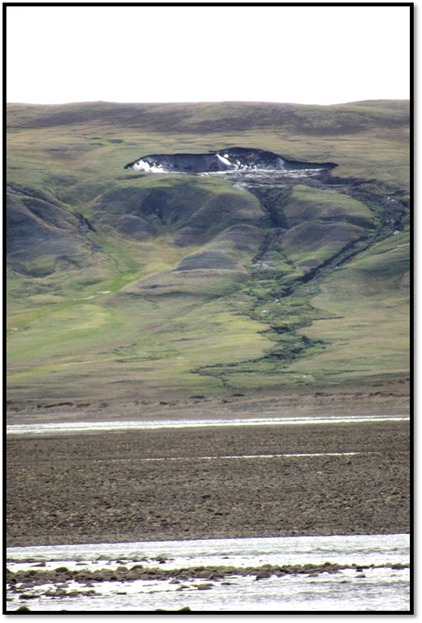
A permafrost slump on Banks Island, NWT. The previously frozen ground has thawed and collapsed, flowing into the river.
I've found most of the challenges you encounter when doing field research is weather and attitude. Rarely, someone may underestimate you for being a woman or because you are quiet; prove them wrong. Don't be afraid to ask for help either though. There is absolutely nothing wrong with getting help when you need it, especially in the field.
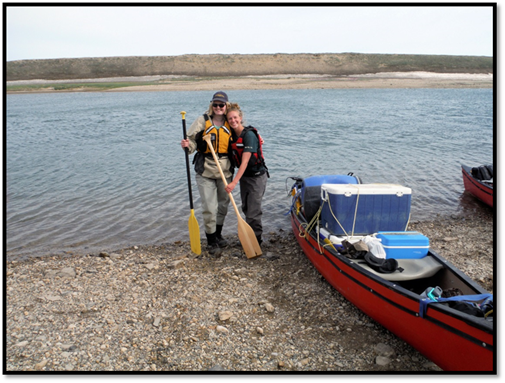
Allison (left) and her canoe partner, Sarah Beattie of Parks Canada, preparing to head out for the day.
I mentioned earlier that the people you meet can make or break your field experience, just as you can theirs. Being able to laugh together, even in high winds and rain, is SO important.
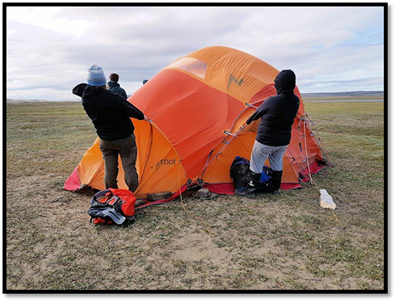
Allison and another team member holding up the cooking tent against the 30-40 km/h winds while other team members fix a snapped pole on the other side. Photo by Sally Esau of Parks Canada
What you get to see and do is the other major benefit of field work. Research gives you the opportunity to travel the world and go to some of the most remote places on the planet. It is an absolutely incredible experience.
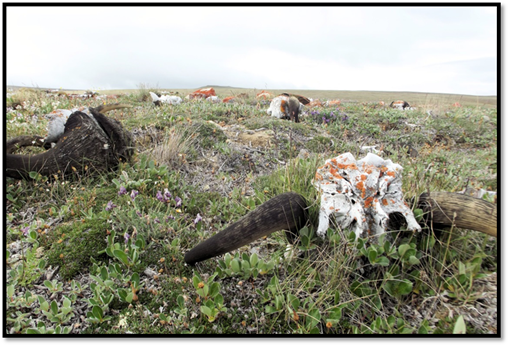
Head Hill Archeological site, an old Inuvaluit muskox hunting and butchering ground. There is an amazing atmosphere in this area.
Finally, you get to learn about a whole range of topics and see how everything is connected. At one of the permafrost thaw slump sites I sampled recently, the slump had made a stream outflow to the main river very muddy. This mud is supposedly highly nutrient rich and supported more invertebrates than at other sites we had sampled. Increased invertebrate populations resulted in better fed and seemingly more abundant fish at the mouth of the stream. The abundant fish were likely the reason there was one seagull that would constantly patrol the shallow portion of the main river just downriver of the stream mouth, which I had not seen elsewhere. To me it's absolutely incredible that we can see and possibly connect the behaviour of this seagull with permafrost thawing: that's why I love environmental field research. If you ever get the opportunity to give field research a try, do it, give it a fair chance and I bet you'll be going back again.
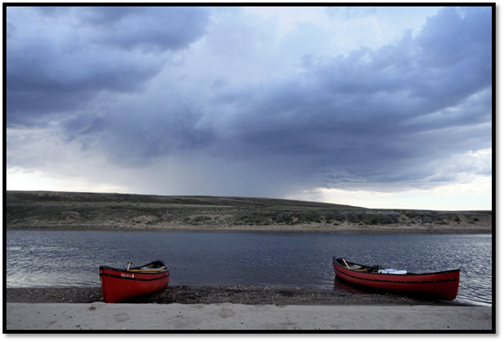
Banks Island welcomed us with some exciting weather and amazing views on the Thomsen River.
